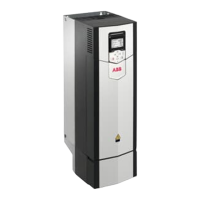Parameters specific to motor overload protection: 35.5 Motor overload
level (page 341), 35.56 Motor overload action … 35.57 Motor overload class (page 350).
■
Thermal protection of motor cable
The control program contains a thermal protection function for the motor cable.
This function should be used, for example, when the nominal current of the drive
exceeds the current-carrying capacity of the motor cable.
The program calculates the temperature of the cable on the basis of the following
data:
• Measured output current (parameter 1.7)
• Nominal continuous current rating of the cable, specified by 35.61, and
• Thermal time constant of the cable, specified by 35.62.
When the calculated temperature of the cable reaches 102% of the rated maximum,
a warning (A480) is given. The drive trips on a fault (4000) when 106% is reached.
Settings and diagnostics
Parameters: 35.60 Cable temperature...35.62 Cable thermal rise time (page 352).
Events: A480 Motor cable overload (page 570) and 4000 Motor cable
overload (page 555).
■
Automatic fault resets
WARNING!
Before you activate the function, make sure that no dangerous situations
can occur. The function resets the drive automatically and continues
operation after a fault.
The drive can automatically reset itself after overcurrent, overvoltage, undervoltage
and external faults. The user can also specify a fault (excluding Safe torque off
related faults) to be reset automatically.
By default, automatic resets are off and must be specifically activated by the user.
Settings and diagnostics
Parameters: 31.12 Autoreset selection…31.16 Delay time (page 319).
■
Other programmable protection functions
External events (parameters
31.01
…
31.10
)
Five different event signals from the process can be connected to selectable inputs
to generate trips and warnings for the driven equipment. When the signal is lost,
an external event (fault, warning, or a mere log entry) is generated. The contents
116 Program features

